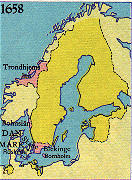

Copyright © Hans Högman 2017-10-27
The Many Swedish
Wars - 1600s
Swedish Wars - 1600s
1600-1629, War with Poland, "The Second
Polish War"
One of the reasons of the war is the Polish King
Sigismund’s demand of the Swedish throne.
Sigismund was a former Swedish king in exile, now a
Polish king. Another reason for the Swedish King
Gustav II Adolf was to conquer the Baltic provinces
and by doing so shutting Russia out of the Baltic Sea.
One of the bloodiest battles in the war was the
battle of Kirkholm on September 17, 1605.
•
Truce between 1611 and 1613.
•
Armistice on January 20, 1614 to September 29,
1616.
•
Armistice in November 1618 for two years.
•
Truce on November 27, 1622 to March 1, 1625.
•
Armistice on September 16, 1629 in Altmark
for a period of six years.
During the Altmark armistice, Poland had ho give up
several important ports and to accept the Swedish
occupation of Livland (red color on the map).
However, the armistice did not solve the problem of
the Polish king’s demand of the Swedish throne.
The arrangement with Brandenburg was settled in
the convention of Fischhausen on November 6,
1629. A settlement with Danzig was made in
Tiegenhoff on February 18, 1630.
No peace treaty until 1660 in Oliva. See below.
Gain of land
:
+ Livland including Riga (The Baltics)
+ Prussian ports (Elbing, Pillau,
Braunsberg Fischhausen, Lochstädt
and Memel)
+ The Danzig trade
Map of sweden 1629
See detailed map.
1635, War with Poland. "The Second Polish
War - The Armistice in Stuhmsdorff 1635"
The armistice in Altmark 1629 was for six year (that
is until 1635). At this time Sweden was involved in
the 30-years war and couldn’t afford a second war in
Poland. New negotiations were held with Poland. To
improve the Swedish position in the talks, Sweden
had an army force of 20,000 soldiers moved to
Prussia in June 1635.
The result was a new armistice in Stuhmsdorff on
September 2, 1635. This armistice was settled for a
very long period, until June 1, 1661.
In the armistice, Sweden was to give up the Prussian
ports inclusive the right to collect duty.
The Polish King’s demand of the Swedish throne was
still not settled.
Gain of land:
- Prussian ports; Elbing, Pillau and
Braunsberg plus Memel
1609-1610, "The De la Gardie Campaign"
A war with Russian rebels (Swedish intervention in
the Russian Civil War). The rebels were supported by
Poland.
Poland was trying to get King Sigismund’s son
Vladislav Vasa elected as new tsar of Russia. Sweden
was against a Russian-Polish alliance. Therefore
Sweden decided to support tsar Vasilij Sjuiskij in the
civil war. A treaty was signed between Sweden and
tsar Sjuiskij on February 28, 1609 in Vyborg. As a
service in return Sweden was to receive Kexholms
län (a province on the border between Sweden and
Russia).
On March 12, 1610 the Swedish Field Marshall Jakob
De la Gardie marched the streets of Moscow with his
army.
In June 1610, De la Gardie were in trouble with his
army and was offered a compromise by the Polish
army. Sweden was to withdraw in peace, if the
Swedish support of tsar Sjuiskij would come to an
end. De la Gardie accepted and withdrew from
Russia.
Soon after that, tsar Sjuiskij was removed and
Vadislav Vasa was elected new tsar of Russia.
Peace treaty on June 23, 1610.
Gain of land:
+- zero
1610-1617, War with Russia, "The
Ingermanland War"
The Swedish purpose with the war was to secure
the eastern borders towards Russia. One of the
plans of this war was to put the Duke Karl Filip as
tsar of Russia. Duke Karl Filip was the brother of the
Swedish king, Gustav II Adolf.
Peace in Stolbova on February 7, 1617.
Russia has to relinquish all claims of Estonia and
Livland. Further, Russia had to pay a war indemnity
of 20,000 roubles to Sweden. Sweden recognizes
Michail Romanov as tsar of Russia. Sweden has to
return the conquered Novgorod to Russia.
The lake Ladoga now becomes natural border
between Sweden and Russia.
With Kekholms län and the greater part of
Ingermanland as Swedish possessions, Russia is now
completely cut out of the Baltic Sea.
Gain of land:
+ Kexholms län (southeast of
Finland)
+ Nöteborg, Jama, Kopore and
Ivangorod with counties, that is
western Ingermanland (Baltic
province)
Map of Sweden 1617
See detailed map.
1611-1612, War with Denmark, "The Kalmar
War"
Denmark considered the peace treaty between
Sweden and Russia in Teusina in 1595 interfering
with Danish territorial interests at the Arctic Ocean.
Russia was in 1595 handing over land to Sweden,
land that the Danes claimed.
In 1611 Denmark was seeking a war with Sweden
and one of the reasons was the Danish land in the
Arctic Ocean, land that Sweden now considered their
territory. Sweden was at this time already at war
with both Poland and Russia and tried to avoid a war
with Denmark. However, Denmark attacked
southern Sweden and on August 3, 1611 the Kalmar
fortress surrendered. The Älvsborg fortress on the
Swedish west coast falls into Danish hands on May
24, 1612.
Peace on January 19, 1613 in Knäred.
Sweden had to pay 1,000,000 riksdaler to Denmark
to regain Älvsborg. Further, Sweden has to withdraw
any claims on the Danish land at the Arctic Ocean.
Sweden also has to return the conquered provinces
of Jämtland and Härjedalen to Denmark.
Gain of land
: - Sweden had to pay to get Älvsborg
back (A Swedish fortress on the west coast)
See detailed map.
1630-1648, "The 30 Years' War" in Germany
The 30 Years' War (Swedish)
Allied with Sweden: A number of German states plus
France between 1638 and 1648.
The background to the 30-year war was a constantly
increasing tension between the Catholics and
Protestants of Europe – a tension that backdates to
Martin Luther and the Reformation in 1517.
The leader of the catholic side was the Emperor of
the Holy Roman Empire with foremost German
Principalities and Spain. On the Protestant side were
Sweden, Denmark, the Netherlands and England. On
the Protestant side there was also the catholic
France.
As a protection against the Holy Roman Emperor,
the German protestant princes established an
alliance in 1608, the Evangelical Union, with the
Elector of Pfalz as a leader.
The following year, in 1609, the Catholics formed an
alliance, the Catholic League, as a counter-measure.
The league had the Bavarian Duke Maximillian I as a
leader.
The war broke out in 1618 in the protestant Bohemia
with an uprising against the Holy Roman Emperor.
The Protestants then threw a number of imperial
officials out of a window at the castle of Prague as a
protest when their right of religious freedom was
violated.
After a few years of the war the imperial side had full
control of southern Germany.
The field Marshall of the Holy Roman Empire was
von Wallenstein.
In 1626, Denmark, England and the Netherlands
made an unsuccessful attempt to intervene in the
war against the Holy Roman Emperor.
Even the German princes worries about the success
of the imperial side. They didn’t want a too strong
Emperor. Even France had worries about this. In
1629 the Holy Roman forces had full control of
Germany.
During the 1620’s Sweden was involved in a war in
Poland. After the armistice in Altmark in 1629
Sweden could attend the War in Germany. The
French encouraged a Swedish intervention in the 30-
year war.
There are many reasons why Sweden entered the
war. One was the increased power of the Holy
Roman Empire and their plan of a naval base at the
north German coast at the Baltic Sea. This would
have been a threat to the Swedish plans of
expansion. Then off course there were the
ideological factors concerning the issue of religious
freedom.
In reality, Sweden entered the war when they in 1628
supported the city of Stralsund. Stralsund was at this
time under siege by Wallenstein.
King Gustav II Adolf and Sweden definitely entered
the war when the Swedish army landed on the island
of Usedom in northern Germany in June 1630.
In the beginning the protestant German
principalities did not welcome the Swedish
intervention. However when marshal Tilly and the
imperial forces ruined Magdeburg a agreement was
settled between Sweden and the German
principalities.
In 1636 the French entered the war on the Swedish
side. France also supported Sweden with subsidies,
money that Sweden needed to continue the war.
Sweden and France was the victors of the war.
•
Armistice in Stockholm on July 14, 1641 with
Brandenburg
•
Armistice in Eulenburg on March 31, 1646 with
Sachsen
•
Armistice in Ulm on March 4, 1647 with Bayern
•
Peace in Westfalen on October 10, 1648.
In the peace treaty Sweden received Vorpommern,
parts of Hinterpommern plus Wismar, Bremen,
Verden and the provinces Wildeshausen and
Thedinghausen. Sweden participated between 1630
to 1648. The war started in 1618 and did not end
until 1648.
Gain of land
:
+ Pommern (Vorpommern and a
small part of Hinterpommern),
+ Wismar and Neu-Kloster and the
island Poel (northern Germany)
+ Bremen, Verden (northern
Germany)
Map of Sweden 1648
See detailed map.
1643-1645, War with Denmark, "The War of
Torstensson"
During the 30-year war, Sweden made an
unexpected attack on Denmark. The attack was
made from Germany. The Kalmar War of 1611 - 1612
had shown how difficult it was for Sweden to defend
Älvsborg, the only Swedish gateway on the west
coast at this time, as long as the Danes possessed
land south and north of Älvsborg (were today's
Gothenburg is located).
Sweden had an ambition to gain more territory on
the west coast.
Further, Sweden was exempted from duty in
Öresund, the sound between Sweden and Denmark.
However, Denmark constantly initiated new
exceptions, which irritated the Swedes.
The Commander of the Swedish forces in Germany
marched north with his army at the end of 1643. In
December he was in the Danish controlled Holstein.
In 1644 the whole of Jutland was occupied. Sweden
also attacked the Danish provinces Skåne and
Jämtland/Härjedalen.
Peace on August 13, 1645 in Brömsebro.
In the peace treaty Sweden received Halland on the
west coast for 30 years plus permanently the
provinces Jämtland, Härjedalen, the island Gotland
and the island Ösel (in the Baltic region). Further,
Sweden got total exemption from duty in Öresund.
Gain of land
:
+ Jämtland, Härjedalen
+ Gotland, Ösel
+ Halland for 30 years
Map of Sweden 1645
See detailed map.
1654, War with Bremen, "The First War with
Bremen"
In the peace treaty of Westfalen 1648 after the 30-
year war Sweden obtained the City Bremen inclusive
the county of Bremen in northern Germany.
According to the treaty the city Bremen had the right
to keep its town privileges. However the city refused
to accept Swedish sovereignty. Instead they started
negotiations with the Holy Roman Emperor about
being directly subordinated the Emperor. When the
city got an invitation to the German parliament the
question got very tense.
Bremen was important to Sweden, not the least
from an economical point of view.
Königsmarck, the Swedish governor of Bremen, now
receives enough Swedish military reinforcement to
match the troops Bremen had. The Swedes also
occupies some important places around the city.
However in reality there were no fights in this war
and an armistice was signed in September 1654. The
peace treaty was signed in Stade on November
28, 1654.
In the treaty Bremen honors the Swedish kings and
accepts to follow the Swedish foreign policy. Sweden
promises to protect the city and encourage the trade
on Bremen.
Gain of land
: +- zero
1655, War with the Netherlands
Gain of land
:
- The colony New Sweden, Delaware
and New Jersey, USA
1655-1660, War with Poland, Brandenburg
and the Holy Roman Empire, "The Polish
War of King Karl X Gustav - and the peace in
Oliva 1660"
Allied with Sweden: Brandenburg from January 1656
to September 1657.
The Swedish purpose with this war is not clear. One
of the aims was off course to expand Sweden on
behalf of Poland. Further, the armistice between
Sweden and Poland in Stuhmsdorff 1635 hadn’t
resulted in a peace treaty. Another reason was that
the Polish kings since the days of Sigismund have
claimed the Swedish throne. Sweden also had plans
to stop the Russian expansion westward. Poland was
at this time in a war with Russia.
The war started in July 1655 when the Swedes
launched an attack on Poland both from the west as
well as from the east. The war went on very well for
the Swedes and soon major parts of Poland and
Prussia was in Swedish hands. However, later the
war emerged into a positional war.
In January 1656 Sweden forced Brandenburg to
concessions and they joined Sweden in an alliance
settled in Marienburg on June 15, 1656. In July 1656
a combined Swedish-Brandenburg army conquered
a large polish army in the so-called “three day battle
of Warsaw”. At the same time the Swedish King Karl
X Gustav received information that Russia had
declared war on Sweden on May 17, 1656. Another
misfortune for Sweden in 1656 was that Poland and
Russia signed an armistice in October.
The Swedish agreement with Brandenburg was
renewed in Labiau on November 10, 1656. Nothing
much happened in Poland during early summer of
1657. In March 1657 the Holy Roman Emperor
declared that they would support Poland with
Austrian troops against the Swedes. On June 20,
1657 the Swedish King Karl X Gustav received
information that Denmark had declared war on
Sweden.
Austria, Spain and the Netherlands had persuaded
Denmark to attack Sweden. The wars of the 1600’s
are very complicated with a lot of political alliances
between the European nations. Sweden, with its
expansive moves, had disturbed the balance of
power between the European nations and all did not
accept this. The Netherlands for example, saw it’s
trading interests in the Baltic Sea threatened.
The Danish war changed the situation for Sweden,
so at the end of June 1657 King Karl X Gustav left
Poland with an army corps to deal with Denmark.
See “The First Danish War of King Karl X Gustav”
below. A force of 12,000 Swedish soldiers was left in
Poland to hold the positions. During 1657 also
Brandenburg turned on Sweden.
From this time and to the peace treaty in 1660
nothing much happened in Polish war.
Peace on April 23, 1660 in Oliva.
Poland recognizes the Swedish possession of
Estonia, the island of Ösel and Livland north of river
Düna. Livland had been in Swedish hands since 1621
when King Gustav II Adolf conquered the city of Riga.
The Polish King Johan Kasimir relinquished, for
himself and all his successors, all claims of the
Swedish throne for eternal time.
With the Holy Roman Emperor there was a treaty
about withdrawal of all imperial troops from the
Swedish Pommern and Mecklenburg.
The treaty with Brandenburg released Brandenburg
from the agreements of Königsberg, Marienburg and
Libiau. Sweden also recognized the Elector of
Brandenburg’s sovereignty as Duke of East Prussia.
Gain of land
: +- zero
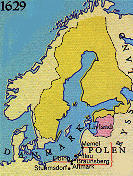
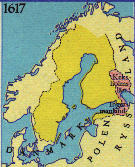
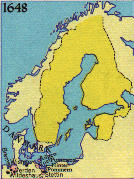
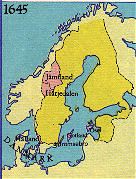
1656-1661, War with Russia, "The Russian
War of King Karl X Gustav"
In the middle of the Swedish war in Poland, Russia
declared war on Sweden. One of the Russian
purposes with the war was to extend the Russian
borders to the Baltic Sea. In the beginning of July
1656 Russian forces crossed the Swedish borders in
Finland and in Livland. Sweden, which at the time
were involved a war in Poland, tried to end the war
with Russia as soon as possible.
After the peace with Russia of 1617 in Stolbova
there had been no hostilities along the Swedish-
Russian borders, so the Russian war came as a
surprise.
Russia had some success in the beginning of the
war but then there were very few activities in the
war.
•
Armistice in the village of Valiesar, south of
Narva on December 20, 1658. The armistice
was for three years and Russia was to keep
captured areas.
The peace treaty was signed on June 21, 1661 at
the estate Kardis in the Lais parish. In the peace
treaty Russia was to return all captured areas to
Sweden. In the beginning of the negotiations the
Russians were reluctant to return any areas to
Sweden. The Swedes then gathered a force of
25,000 soldiers, which made the Russians more
willing to accept the terms of the treaty.
Gain of land
: +- zero
1657-1658, War with Denmark, "The First
Danish War of King Karl X Gustav"
On June 20 1657, when King Karl X Gustav and the
Swedish Army was involved in a war in Poland, the
King got information on Danish hostilities. Austria,
Spain and the Netherlands had persuaded Denmark
to attack Sweden. At this time Sweden was also
involved in a war with Russia.
On June 16, 1657 Denmark made an attack on
Swedish Bremen in northern Germany. On June 23,
the Swedish King left Poland with a force of 6,000
soldiers. The destination was Denmark. The force
was small, but this was probably the best and most
experienced soldiers at the time. The majority of
these Swedish soldiers had participated in more
than 30 battles. In Swedish Pommern more soldiers
joined the force. The Danish army mostly consisted
of fresh recruits and they were now about to meet
the most efficient army at the time.
About 12,000 Swedish soldiers was left in Poland to
hold the positions.
Soon, the Swedes had occupied Jutland. The
fortress Frederiksodde was besieged in August. On
October 24 the fortress was taken. The Swedes now
controlled the whole of Jutland. At the end of
December the weather changed and turned very
cold. In January 1658 the sea water around
Denmark froze to ice. Early in the morning on
January 30, the Swedes set off on the ice from
Jutland to the island Fyn. This was a risky gamble,
but it paid off. About 12,000 Swedish soldier
marched on the ice over the sound Lilla Bält to
Fyn. On January 31 the island Fyn was in Swedish
hands. On February 5 1658 the Swedes moved out
from Fyn on the ice over the sound Stora Bält via
the islands Langeland and Lolland to Zealand. The
Swedish army was now close to Copenhagen, which
they reached on February 15. The Danes were now
ready for peace talks.
Peace on February 26, 1658 in Roskilde.
In the peace treaty Sweden received the Danish
provinces; Skåne, Blekinge, Halland, Bohuslän, the
island Bornholm and Trondheim county in today’s
Norway. Halland became Swedish for a period of 30
years in the peace treaty of Brömsebro in 1645.
Now it permanently became a Swedish province.
Sweden now had natural borders in the south and
on the west coast. Further, Denmark and Sweden
were to stop all foreign navies from entering the
Baltic Sea.
In the peace treaty Denmark lost about 1/3 of its
area.
King Karl X of Sweden marches via Jutland on the ice
to the Bält islands and to Zealand in January, 1658.
Gain of land
:
+ Skåne, Blekinge, Halland
+ Bohuslän
+ Trondheims län
+ Bornholm
Map of Sweden 1658
See detailed map.
1658-1660, War with Denmark, "The Second
Danish War of King Karl X Gustav"
The Danes did everything they could to avoid
fulfilling the agreements of the Roskilde peace
treaty of February 1658. The Swedish King Karl X
Gustav got furious at the Danes and wanted to
settle this once and for all. His aim was to return to
Denmark with his army and this time totally crash
Denmark.
In August 1658, just 6 month after the peace in
Roskilde, Sweden launched an attack on Denmark.
The King made it clear to the Danes that this was
not a new war but an extension of the first war.
Once again Denmark was attacked from the south,
this time from Kiel via Korsör to Copenhagen. On
August 6, 1658 the Swedes set sail from Kiel.
Onboard the ships there were 5,700 very
experienced soldiers. Sweden was still occupying
Jutland (Jylland) and held a force on Fyn. Swedish
troops had also been gathered in Skåne.
On August 11, 1658, Copenhagen was once more
under siege. The Swedish navy was bombarding the
city from the sea. Copenhagen was totally cut off.
The Kronborg fortress at Helsingör, about 40 – 50
km north of Copenhagen, surrenders on September
6.
The central European nations had watched Sweden
grew and become a powerful nation during and
after the 30-year war. The Swedish army was
experienced and well trained and spread fear in
Europe.
It was a belief that is wasn’t good if Sweden would
become too powerful. They wanted a balance in the
North and by crashing Denmark Sweden would
have disturbed that balance. The Netherlands had
large trading interests in the Baltic Sea and now saw
its interests threatened. Therefore the Netherlands
sent a navy fleet to help the Danes in the war.
Sweden was hoping on help from Cromwell and
England. Sweden had good relations with Cromwell
but he died early in September.
Also, an allied force of 24,000 soldiers was set up by
Brandenburg, Austria and Spain to help Denmark.
When the Dutch fleet was in sight on October 27,
1658 the Swedish admiral Wrangel wanted to
attack. It was a southerly wind, which was in favor of
the Swedes. The King however wanted to wait and
see if the Dutch were to stay neutral or hostile. If
the Dutch were neutral it would have been a
mistake to attack.
However, the Dutch fleet turned out to be hostile
and when the Swedes were about to attack on
October 29, the wind had changed to a northerly
win, which was in favor of the Dutch.
The Dutch fleet consisted of 35 men-of-war and 60
cargo ships with supplies and 6 troop transport
ships with 3.000 infantry soldiers. The Swedish fleet
consisted of 45 men-of-war.
The naval battle took place in the sound between
Sweden and Zealand (Själland) and was a very
bloody battle. The battle lasted for 6 hours.
During the battle the Dutch cargo ships and the
troop transport ships managed to pass the fighting
ships and head for Copenhagen.
This was a serious misfortune to the Swedes. The
Swedish navy had failed to stop the Dutch fleet
from reaching Copenhagen. After the battle the
Swedish fleet withdrew to Landskrona.
In September, the allied forced was moving north
on Jutland. The Swedes on Jutland finally had to
withdraw to the Fredriksodde fortress. At the end of
1658 Sweden was only controlling Fyn and Zealand.
The Swedes saw Copenhagen as the key to victory.
Just after midnight on February 10, 1659 the Swedes
tried to capture Copenhagen. However the assault
on Copenhagen failed.
On May 16, 1659 the Swedes withdraw from their
last stronghold on Jutland, Fredriksodde.
The Danish King Frederik III persuaded the allied
forces on Jutland to launch an attack on Fyn and
they made three attempts during the summer
without succeeding. All three assaults caused a
great deal of causalities among the allied units.
In the autumn of 1659 the Swedish navy meet the
combined Dutch-Danish navy.
But then the English navy arrived at the scene. The
Dutch stopped the attack on the Swedes and
prepared to fight the English. The English had no
wish to fight the Dutch, if they didn’t have to, so
there was no battle between the two fleets.
The English wasn’t there to help the Swedes but to
keep an eye on the Dutch. They weren’t going to
allow the Dutch to take advantage on the Swedish –
Danish war. So the English were merely looking
after their interests.
In November the Swedes also have to give up Fyn.
In the beginning of 1660 the war developed into a
positional war. There were very few military
activities.
England, France and the Netherlands started to
mediate for a peace treaty. King Karl was reluctant
to give up any land but when he died on February
13, 1660 the Swedes accepted to return Trondheim
in Norway and he island Bornholm to Denmark. The
Dutch were thereby satisfied and their fleet left the
region. King Frederik III of Denmark wanted more
than Trondheim and Bornholm so he refused the
proposal. However, the Danes were now without
protection of the Dutch navy. The Swedish navy set
sail for Copenhagen and King Frederik soon
changed his mind about the proposal. The
negotiations between Sweden and Denmark began
on March 24, 1660.
The peace treaty was signed in Copenhagen on
May 27, 1660. Sweden was to return the Trondheim
County in Norway and the island of Bornholm to
Denmark. The Danes didn’t have to compensate
Sweden for the African colony Cabo Corso that the
Danes captured from Sweden in 1658. Further, the
part of the Roskilde peace treaty stating that
Denmark and Sweden were to stop all foreign
navies from entering the Baltic Sea was stroke out
from the treaty.
Gain of land
:
- Trondheims län,
- Island Bornholm
1666, War with Bremen, "The Second War
with Bremen"
In the peace treaty of Westfalen 1648, after the 30-
year war, Sweden obtained the City Bremen
inclusive the county of Bremen in northern
Germany. However the city refused to accept
Swedish sovereignty. This caused a war in 1654,
which was settled in the peace of Stade in 1654.
However, Bremen still refuses to accept Swedish
sovereignty and in 1665 Sweden decides to deal
with Bremen. In January 1666 a military Swedish
force marches from Swedish Pommern towards
Bremen. For the time being the force didn’t use any
violence. Bremen kept on refusing Swedish
sovereignty and in August the Swedes starts a
blockade of the city. The Swedish force now consists
of 11,000 soldiers. The combat starts on August 31.
In September the German state Lüneburg started to
interfere in the conflict on behalf of Bremen. There
was also a risk for the Swedes that other German
states would do the same.
On September 22 a negotiation ended in nothing
and the Swedes continued the bombardment of the
city.
There was also information that the Netherlands,
Denmark, Brandenburg and Lüneburg was about to
form an alliance against Sweden. This made the
situation very difficult for the Swedes and Sweden
began new talks with Bremen. Sweden had to make
some concessions in order to get a treaty and at the
end of October the two parts are very close to a
deal.
The peace treaty was signed on November 15,
1666 in Habenhausen.
In the peace treaty Bremen received the right to be
directly subordinated the Holy Roman Emperor.
However Bremen did not have the right to visit the
German parliament until 1700. Further, Bremen was
to pay taxes to both Sweden and the Holy Roman
Emperor.
Gain of land
: +- zero
See detailed map.
1675-1679, War with Denmark,
Brandenburg and the Netherlands. "The
War of King Karl XI"
Sweden was an allied of France.
When King Karl X Gustav of Sweden died in
February 1660, the crown prince Karl was merely 5
years old. So, between 1660 and 1672, (when the
crown prince formally became the Swedish regent),
Sweden had a regency. During this period of
regency, the Swedish armed forces were badly
neglected and in 1672 the financial situation was a
mess.
The Swedes saw a solution to their problems when
France wanted a military alliance with Sweden in
1672. France was to pay a lot of subsidies to
Sweden if the Swedes allied with France. The
alliance was first of all directed towards the
Netherlands.
The alliance was signed on April 4, 1672. France also
promised not to support a possible Danish attack
on Sweden.
However the ink had hardly dried on the treaty
when France launched an attack on the
Netherlands. The Netherlands allied with the Holy
Roman Empire and Brandenburg.
So, without wanting it, Sweden was now involved in
a war in continental Europe.
In the beginning of the war Sweden tried so stay out
of it and made a lot of efforts to start mediation.
Most of the nations in Europe either supported the
Netherlands or stayed neutral. Sweden stood alone
as an allied of France.
In the beginning, the war went well for France.
However, then the war changed and France
demanded Sweden to enter the war. At the end of
1674 Sweden sent a force of 11.000 – 13.000
soldiers from Pommern to Brandenburg.
In 1675 several nations declared war on Sweden:
June 5, 1675 – the Netherlands
July 8, 1675 – the Holy Roman emperor
September 2, 1675 – Denmark
Other nations that Sweden now was in war with
were Spain plus the principalities of Lüneburg and
Münster.
The first battle for the Swedes was in Fehrbellin on
June 18, 1675.
Ever since the peace of Roskilde in 1658, Denmark
has had plans to regain their lost territory to
Sweden. Now when Sweden was at war, Denmark
saw a chance and joined the Dutch alliance and
turned on Sweden.
The war in Germany went badly for the Swedes and
soon all of the Swedish provinces in northern
Germany were under attack.
Denmark also moved the war to Sweden. In October
1675 a force from the Danish Norway attacked
Bohuslän. However the Swedish counterattack was
successful. In May 1676 the Danes occupied the
island of Gotland. On June 1st the a Danish-Dutch
navy won an important naval battle south of the
island Öland. By the victory the Danes controlled
the sea, which made it possible for them to ship
troops to Skåne. At the end of June 1676 Denmark
landed troops in province of Skåne and in August
the province was in Danish hands.
King Karl XI acted immediately on the Danish
attacks of Sweden and through a series of battles
the Danish attack was stopped and the Danish
dream of getting Skåne back remained a dream.
On May 17, 1676 the Swedish army won an
important battle at Halmstad.
In one of bloodiest battles in Swedish history, the
Danes were defeated in the Battle of Lund in
December 4,1676. More than 9.000 soldiers were
killed, about 4.000 Swedes and 5.000 Danes.
Sweden defeated the Danes and this was an
important turn point of the war.
In 1677 the Danes once again tried to recapture
Skåne but once again they failed. The Swedes won a
large battle on July 14 1677 at the battle of
Landskrona.
During the fall of 1678 the Danes finally gave up
their attempts to recapture Skåne and started to
evacuate their troops in Sweden.
The war in Germany still went badly for the Swedes
and in November 1678 the last Swedish stronghold
in Germany falls in the hands of the enemy.
Nothing much happened in the war during 1679.
As early as in 1676 France and the Netherlands
started to prepare for peace. However the war
didn’t end until 1679 when a series of peace treaties
were signed between the participants of the war.
The Swedish peace treaties:
•
The first peace treaty in Nijmegen on January
26, 1679 – with the Holy Roman Empire
•
The peace treaty in Celle on January 26, 1679 –
with Lüneburg
•
The second peace treaty in Nijmegen on March
19, 1679 – with Münster
•
The peace treaty in S:t Germain on June 19,
1679 – with Brandenburg
•
The peace treaty in Fontainbleu on August 23,
1679 – with Denmark
•
The third peace treaty in Nijmegen on October
2, 1679 – with the Netherlands
There was no peace treaty between Sweden and
Spain. However a jointly declaration for peace was
ratified on August 6, 1679.
The territorial losses would have been a great deal
higher if Sweden hadn’t been “protected” by France
in the negotiations. On the other hand, Sweden was
an allied of France and forced into the war.
Now Sweden only had to do some minor territorial
cedes in northern Germany.
However, France didn’t always bother about the
Swedish demands and forced agreements with the
other nations independently what Sweden wanted
to get out of he negotiations.
More about the terms of the peace treaties.
In one of bloodiest battles in Swedish history, the
Danes were defeated in the Battle of Lund, 1676.
